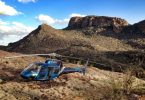Tanzania is the land of wonders and shall forever remain so. One of the mysteries of this East African country is Ol Doinyo Lengai stratovolcano in the Gregory Rift of Arusha.
Ol Doinyo Lengai is strangely one of the last active volcanoes in the African continent producing unique deposits known as natrocarbonatite lava. Its name was derived from a Maasai word, Ol Doinyo Lengai, meaning “the mountain of God”. The stratovolcano oozes deep mystery due to its active volcanic activity centuries later. There are very few places in the world with active stratovolcano mountains.
A stratovolcano has several layers of lava, compact ash and rocks that formed after many other eruptions.
Also read: All About The Lions Of The Serengeti In Tanzania

Ol Doinyo Lengai [Photo by Sacred Sites]
The fascination of Ol Doinyo Lengai is immeasurable. This stratovolcano cuts through East Africa’s Rift Valley towering at 2000m with a summit elevation of 2890m. When at its peak in underground operations, the mountain erupts carbonatite lava which amazed scientists after its discovery in the 1960s. What is interesting about the lava eruption is that they are silica-based on natroncarbonate!
What’s unique about the carbonatite lava flow from the Ol Doinyo Lengai is its rich nature in sodium and potassium carbonites – very rare – as well as gregoryite and nyerereite deposits which make it appear shiny black in the sun due to the low temperatures in the mountains. In other cases, lava flow appears red hot.
At night though, it is extremely fluid and black in colour but turns into a powder white once it cools down or when raining.
Ol Doinyo Lengai’s carbonatite ash which spreads to the surrounding areas greatly influences the annual wildebeest migration from Maasai Mara in Kenya into the Serengeti in Tanzania. The ash enriches the soil and pasture blossoms, making it a harbour for feeding, giving birth and calving for the wildebeest from October onwards.
Also read: Wildebeest Migration; The Right Time To Visit Kenya And Tanzania
Millions of wildebeest cross over to the Serengeti in Tanzania from Maasai Mara in Kenya. The wildebeest have kept this cycle for years on end and it is informed by the availability of pasture in different seasons. With soil and ash deposits from years of volcanic activity, pasture for wild animals is enriched. It grows in seasons.
Ol Doinyo Lengai is one of the few carbonatite volcanoes in the world and Homa Mountain spreading to Kenya’s Western and Nyanza regions is a product of old and extinct carbonatite lava deposits. Carbonatite is an extrusive igneous rock with half of its composition made up of carbonate minerals.
The biggest explosion to have happened and recorded was in 1966. It erupted leaving a massive dip crater. No casualties were reported at the time but scientists said that that the effect was massive and anyone to have survived that must have been extremely lucky. In 1993, there were minor eruptions reported in the mountain. This one had no effect at all.
In 2007, there was volcanic activity in the mountain which caused a 6-day tremor in Tanzania and Kenya. Months later, the volcano erupted, a process that continued into 2008.

Ol Doinyo Lengai [Photo by Sacred Sites]
The lava flow resulted in a small lava lake which was captured in 2010 in an aerial view and natrocarbonatite flow resumed in 2013, filling the crater formed by the 2007-08 eruption. It is, however, not accessible to climbers.
Also read: Will Smith On Safari At The Serengeti National Park In Tanzania
For mountain climbers temperature go as high as 40 degrees celsius, hence climbs are mostly organized after midnight to reach the summit in the sunrise. Temperatures are slightly lower at night and there is some fascination in mountain climbing at night. When climbers near the summit, the feet are illuminated and it is unbelievable.
The views at the summit are impressive, on the north Lake Natron is visible, the westside view gives you the Great Rift Valley, and the eastern part offers majestic views of Mount Kilimanjaro.








